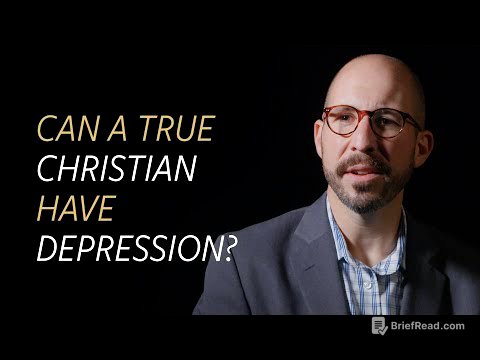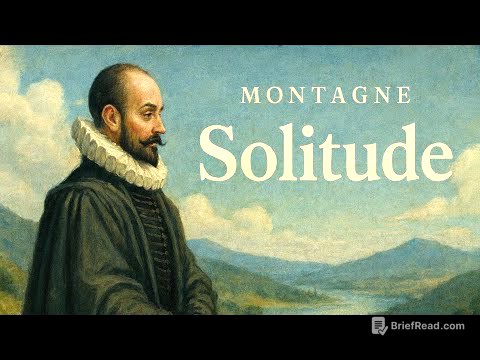TLDR;
This YouTube video features neurologist Dr. Shweta Adatia discussing the limitless potential of the human brain, comparing the brains of yogis and ordinary individuals. She touches on the default mode network, brain waves, intuition, and the science of breath. Dr. Adatia also shares insights on reversing brain age with meditation, the importance of mindful living, and the power of collective thought. The conversation includes practical tips for incorporating meditation into daily life and highlights the significance of mental nutrition.
- Brain of yogi vs normal brain
- Default mode network
- Brain Waves
- Meditation and mindful living
Promo [0:00]
The video promotes an upcoming discussion with neurologist Dr. Shweta Adatia, who will explore the potential of the human brain. It mentions research on a Buddhist monk named Mingyor Rinpoche, whose brain appeared younger than his actual age due to meditation. The promo suggests that meditation is often mistakenly seen as something only for spiritual figures, but it emphasizes the importance of paying attention to one's brain health.
Yogi Brain vs. Normal Brain: Similarities & Differences [1:24]
Dr. Adatia begins by expressing her enthusiasm for discussing the brain, likening it to mathematics where understanding leads to mastery. She notes that while information about the brain is readily available, its practical application is lacking. Dr. Adatia shares her personal journey, recounting how early exposure to meditation with her spiritual teacher didn't resonate until later in life when she faced emotional challenges. She emphasizes that while the brain can understand concepts intellectually, the mind needs to be educated and strengthened to cope with life's challenges.
Default Mode Network: Past, Present & Future [3:43]
Dr. Adatia introduces the Default Mode Network (DMN), a brain area responsible for connecting past experiences with future expectations. She explains that the DMN is constantly active, often preventing the brain from staying in the present moment. In yogis and meditators, this network is less active, allowing them to remain more present. A less active DMN reduces worrying about the future and thinking about the past, which helps to reduce anxiety and depression.
The Three Brain Parts & The "Treasure Chest" (PFC) [7:14]
The brain is divided into three parts: the brain stem, the limbic system, and the prefrontal cortex (PFC). The brain stem controls basic survival functions, while the limbic system governs emotions, constantly scanning for comfort and potential threats, often triggering fight, flight, fear, or freeze responses. The prefrontal cortex is described as a "treasure chest" for human existence, essential for innovation, intuition, emotional balance, and regulation. Yogis and meditators develop and activate the PFC through their practices, mastering their body, mind, and intellect.
Brain Waves: Beta, Alpha, Theta, Delta & Gamma [8:50]
Normal brain activity cycles through beta (active), alpha (relaxed), theta (pre-sleep), and delta (sleep) waves. However, constant phone use can lead to "brain rot," characterized by a single, idling rhythm. In contrast, yogis and meditators exhibit a super brain wave called gamma, operating at 50-100 Hz. Gamma waves amplify cognitive functions, enhance intuition, and enable quick thinking and problem-solving.
Sixth Sense: Intuition & Divine Connection [11:00]
Beyond the five senses, there exists a "sixth sense" or intuition, which facilitates divine connection and the ability to anticipate events. This intuition is amplified in individuals with heightened gamma brain wave activity, transforming the brain into an antenna for subtle cues and insights.
Brain Entrainment & Mirror Neurons [11:52]
Brain entrainment occurs when brain waves synchronize with those of others, especially in the presence of great saints or during live events like music shows or meditations. This resonance is facilitated by mirror neurons, which allow observers to experience similar brain activity and neurochemical release as the performer or meditator.
Making Meditation Accessible: "It's Not Just for Babajis" [13:50]
Meditation is often perceived as being exclusively for spiritual figures, but it is essential for everyone, especially in today's stressful world. Even short meditation practices can be beneficial. A 10-year-old child can meditate better than an adult. The key is to find opportunities for practice amidst daily routines, such as meditating during traffic.
The Mind's Nature : Constant Thoughts & Distractions [16:00]
The mind is naturally inclined to wander and create distractions. Recognizing this, one should not identify with the mind ("I mind") but rather observe it ("my mind"), prompting the question of "Who am I?". Establishing a consistent routine that includes meditation, oxygenation, visualization, exercise, reading, and scribing can optimize time and promote well-being.
The Miraculous 21 Days Gratitude Experiment [18:58]
An experiment involving 25 volunteers who practiced a simple five-minute gratitude meditation for 21 days revealed remarkable results. Participants thanked their bodies and organs daily, leading to an average reduction of 3.8 years in their biological age. This highlights the potential of gratitude practices to reverse the aging process and improve overall health.
Reversing Brain Age with Meditation: The Mingyur Rinpoche Study [21:12]
The video references the research on Buddhist monk Mingyur Rinpoche, whose brain appeared younger than his actual age due to regular meditation. Brain scans showed that his brain volume did not decrease with age as expected; instead, it showed gains. This suggests that meditation can counteract age-related brain shrinkage and promote brain health.
The Science of Breath & Swara Vigyan [22:30]
The two nostrils correspond to the sympathetic (right) and parasympathetic (left) nervous systems. Balancing breath flow between the nostrils is crucial for managing energy levels and promoting relaxation. Techniques like using a Yogadanda can help reset the autonomic nervous system and balance breath flow.
Habit, Routine, Ritual: The Key Distinction [25:25]
Habits are daily activities done without much thought, while routines are sequences of actions performed regularly. Rituals, on the other hand, are habits performed mindfully and with consciousness. Cultivating rituals is essential for spiritual growth and rewiring the brain. Recent studies suggest that change can occur instantly with a firm decision and conscious effort.
Global Consciousness Project: The Power of Collective Thought [28:10]
The Global Consciousness Project monitors random number generators worldwide and has found that during major global events, these numbers become less random, indicating a collective coherence in human consciousness. This suggests that collective thought and emotions can influence global events and that coherence in frequency is important.
Doctor's True Definition: To Teach & Empower [30:19]
The true role of a doctor is to teach and empower individuals to adopt healthy lifestyles. While medication has its place, it should not replace the importance of proper nutrition and lifestyle choices.
Mental Nutrition: The Biggest Nutrition [30:56]
Mental nutrition is the most important form of nutrition. Constantly feeding the mind with negativity and stress leads to unhappiness. It's essential to cultivate positive mental habits and avoid unnecessary stress.
Dr. Sweta's Personal Brain Scans (150+ EEGs) [31:19]
Dr. Adatia shares her personal experience of undergoing over 150 brain scans to understand and improve her brain function. She focused on achieving limbic control, prefrontal cortex development, and optimal brain coherence through sadhana, rule-following, and sacrifice.
The Three Gunas: Tamas, Rajas, Sattva [32:24]
Everything is influenced by the three Gunas: Tamas (laziness, lack of focus), Rajas (hyperactivity, emotional charge), and Sattva (balance, coherence). The goal is to cultivate Sattva, where the prefrontal cortex is active, and the brain, heart, and breath are in sync, leading to bliss and happiness.
What is Meditation? Dispelling Myths & Exploring Yog Nidra [35:51]
Meditation is not about stopping the mind or visualizing specific colors. There is no universally accepted definition of meditation, but it generally involves sitting still to maintain the connection between mind and body. Meditation is not just relaxation and can be practiced in various postures, including lying down, as in Yoga Nidra.
The Importance of Mindful Living: Breath & Food [39:17]
Mindful living involves being aware of one's breath and avoiding unnecessary waste of breath on trivial matters. It also includes eating food mindfully, without distractions like TV or phones. Mental and physical nutrition, along with a healthy lifestyle, are essential for overall well-being.
Placebo Effect & Rewiring Principles of Health & Wellbeing [41:31]
The placebo effect demonstrates the power of the mind in healing. Understanding the principles of health and well-being is crucial for rewiring the brain and promoting overall wellness. Most people focus on health, wealth, or relationships, while only a small percentage seek evolution and self-discovery.
Euclid Satellite: The Vastness of the Universe [43:19]
The Euclid satellite captured images of 1.5 million galaxies, representing only a tiny fraction (0.1%) of the universe. The universe has neither a beginning nor an end. The concept "yatha brahmande tatha pinde" suggests that the entire universe exists within us.
The 500 Sq Ft House Analogy: Our Ego vs. Potential [44:12]
A story illustrates how people often confine themselves to a small area of their potential, like living in only 500 square feet of a 5000 square foot house. The remaining space is occupied by ego, which hinders personal growth and limits existence. Meditation can eliminate ignorance and burn past karmas.
Rapid Fire with Dr. Shweta Adatia [46:00]
- If not a neurologist, Dr. Adatia would be a food photographer.
- She wishes she had embraced vertical meditation earlier.
- A book that changed her life is "5 AM Club" by Robin Sharma.
- Her favorite brain hack is Power Brahmari.
- She is trying to break the habit of not waking up early in Brahma Muhurta.
- She is inspired by people who grow through their struggles.
Final Message: Thrive, Not Just Survive [47:55]
Life is precious, and it's essential to be grateful for being alive. The goal is not just to survive but to thrive by fine-tuning the instrument of life—not too loose, not too tight, but just right.









